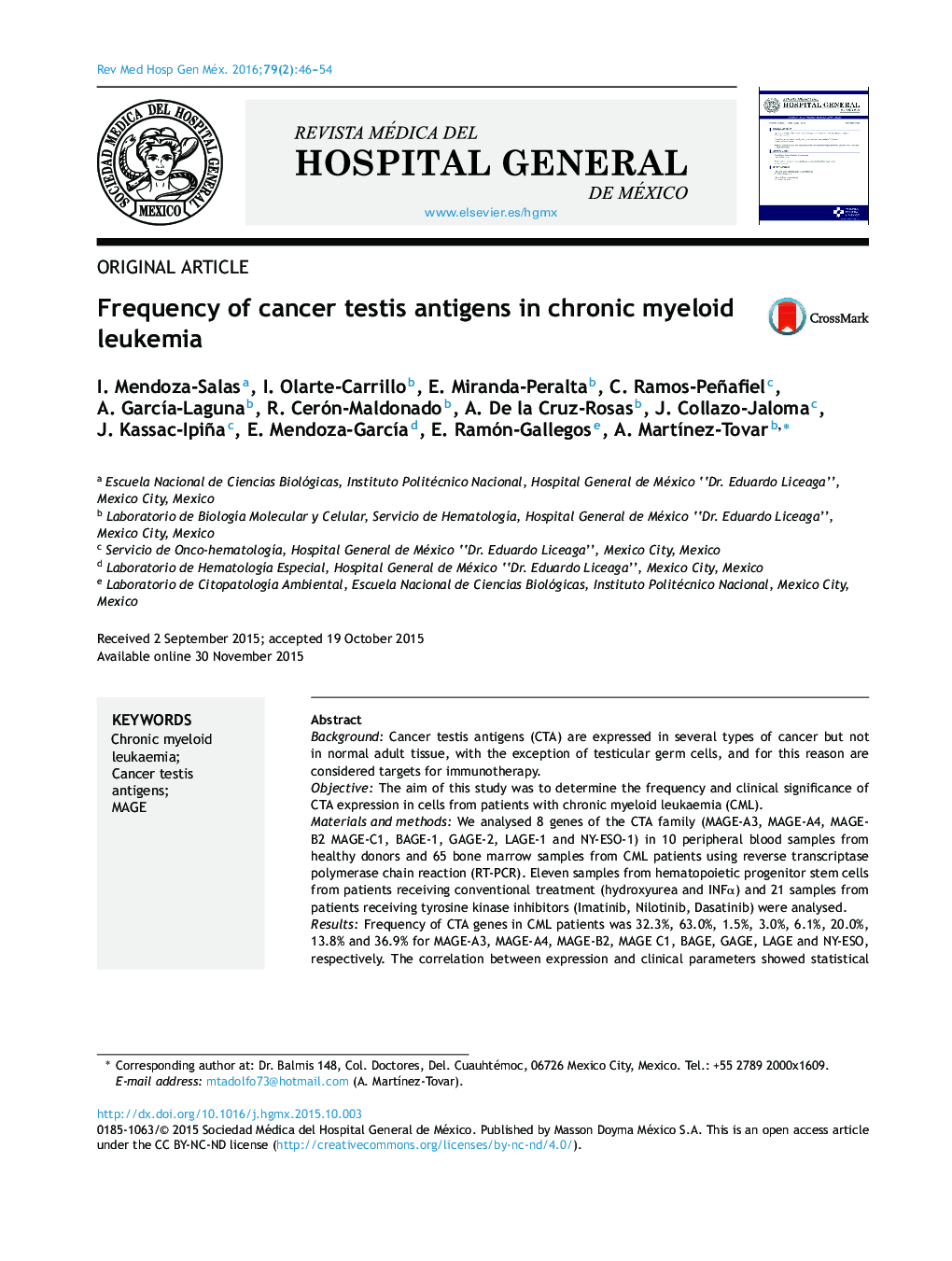| Article ID | Journal | Published Year | Pages | File Type |
|---|---|---|---|---|
| 3830872 | Revista Médica del Hospital General de México | 2016 | 9 Pages |
BackgroundCancer testis antigens (CTA) are expressed in several types of cancer but not in normal adult tissue, with the exception of testicular germ cells, and for this reason are considered targets for immunotherapy.ObjectiveThe aim of this study was to determine the frequency and clinical significance of CTA expression in cells from patients with chronic myeloid leukaemia (CML).Materials and methodsWe analysed 8 genes of the CTA family (MAGE-A3, MAGE-A4, MAGE-B2 MAGE-C1, BAGE-1, GAGE-2, LAGE-1 and NY-ESO-1) in 10 peripheral blood samples from healthy donors and 65 bone marrow samples from CML patients using reverse transcriptase polymerase chain reaction (RT-PCR). Eleven samples from hematopoietic progenitor stem cells from patients receiving conventional treatment (hydroxyurea and INFα) and 21 samples from patients receiving tyrosine kinase inhibitors (Imatinib, Nilotinib, Dasatinib) were analysed.ResultsFrequency of CTA genes in CML patients was 32.3%, 63.0%, 1.5%, 3.0%, 6.1%, 20.0%, 13.8% and 36.9% for MAGE-A3, MAGE-A4, MAGE-B2, MAGE C1, BAGE, GAGE, LAGE and NY-ESO, respectively. The correlation between expression and clinical parameters showed statistical significance in the MAGE-A3 genes in sex (p = 0.018), MAGE-C1 in leukocytes (p = 0.014) in platelets (p = 0.002), and finally LAGE-1, which was associated with platelets (p = 0.001). The hematopoietic progenitor stem cells from patients in treatment showed a higher frequency of expression than de novo patients. In patients receiving conventional drugs (CD), frequency of MAGE-A3 expression was 50%, and 69.2% with TKI, MAGE-A4 frequency was 20% with CD and 53.8% with TKI. Finally, frequency of NY-ESO-1 was 20% with CD and 0% with TKI. The frequency of MAGE-A4 expression was highest, followed by MAGE-A3, NY-ESO-1, GAGE-2, LAGE-1, BAGE-1, MAGE-B2 and MAGE-C1.ConclusionDetection of CTA genes by molecular biology techniques is important due to their use as biomarkers in LMC, in the monitoring of disease progression and in patients who are resistant to chemotherapy. The frequency of CTA expression in treated and de novo differs significantly.
ResumenAntecedentesLos antígenos testiculares de cáncer (ATC) están expresados en diversos cánceres, pero no en tejido adulto normal, con excepción de células germinales de testículo, por esta característica son considerados como blancos para inmunoterapia.ObjetivoEl objetivo de este trabajo fue determinar la frecuencia de expresión de los ATC y su impacto clínico en células de pacientes con leucemia mieloide crónica (LMC).Material y métodosSe analizaron a nivel molecular 8 genes pertenecientes a los ATC (MAGE-A3, MAGE-A4, MAGE-B2 MAGE-C1, BAGE-1, GAGE-2, LAGE-1 y NY-ESO-1) en 10 muestras de sangre periférica (SP) de individuos sanos y 65 muestras de médula ósea de pacientes con LMC, mediante reacción en cadena de la polimerasa por transcriptasa reversa (RT-PCR). Además, se analizaron 11 muestras de células progenitoras hematopoyéticas de pacientes que estaban en tratamiento con fármacos convencionales (Hidroxiurea e interferon alfa) y 21 pacientes con inhibidores de tirosina cinasa (Imatinib, Nilotinib, Dasatinib).ResultadosLa frecuencia de los genes ATC en pacientes con LMC fue de 32.3%, 63.0%, 1.5%, 3.0%, 6.1%, 20.0%, 13.8% y 36.9% para MAGE-A3, MAGE-A4, MAGE-B2, MAGE-C1, BAGE, GAGE, LAGE y NY-ESO respectivamente. Se encontró correlación entre la expresión de los genes MAGE-A3 en sexo (p = 0.018), MAGE-C1 leucocitos (p = 0.014) y plaquetas (p = 0.002) y finalmente LAGE-1 el cual se asocia con plaquetas (p = 0.001). Las células progenitoras hematopoyéticas de pacientes en tratamiento presentaron una mayor frecuencia de expresión que los pacientes no tratados, en los pacientes con tratamientos convencionales la frecuencia de los genes MAGE-A3 fue del 50% y con ITK de 69.2%, para MAGE-A4 fue de 20% en FC y 53.8% en ITK, por último el gen NY-ESO-1 en FC fue del 20% y en ITK no se encontró expresión. La frecuencia de expresión del gen MAGE-A4 fue mayor comparada con los otros ATC.ConclusiónLa detección de los genes ATC por medio de técnicas de biología molecular es de gran relevancia ya que pueden ser utilizados como marcadores tumorales en LMC. Existe una diferencia significativa entre la frecuencia de expresión de los genes ATC entre los pacientes con y sin tratamiento.
